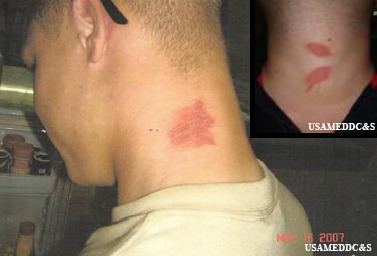 | ||
Paederus dermatitis (also called linear dermatitis or dermatitis linearis) is skin irritation resulting from contact with the hemolymph of certain rove beetles, a group that includes the genus Paederus. Other local names given to Paederus dermatitis include spider-lick, whiplash dermatitis, and Nairobi fly dermatitis.
Contents
The active agent is commonly referred to as pederin, although depending on the beetle species it may be one of several similar molecules including pederone and pseudopederin.
"Blister beetle dermatitis," a term more properly used for the different dermatitis caused by cantharidin from blister beetles, is also sometimes used to describe paederus dermatitis caused by rove beetles.
Diagnosis and treatment
Once pederin is on the skin from the initial beetle contact, it may also be spread elsewhere on the skin. "Kissing" or "mirror-image" lesions where two skin areas come in contact (for example, the elbow flexure) are often seen. Washing the hands and skin with soap and water is strongly recommended, if contact with a rove beetle has occurred.
Initial skin contact with pederin shows no immediate result. Within 12–36 hours, however, a reddish rash (erythema) appears, which develops into blisters. Irritation, including crusting and scaling, may last from two to three weeks.
One study reported best results with a treatment regimen that combined topical steroids with oral antihistamines and antibiotics. The authors hypothesized that antibiotics were helpful because of the possible contamination of skin by pederin-producing bacteria.
Location and species
Three different genera of rove beetles, all members of the same subtribe Paederina, can cause paederus dermatitis: Paederus, Paederidus, and Megalopaederus. This irritant is called pederin and is highly toxic, more potent than cobra venom.
In different parts of the world, different species of rove beetle cause Paederus dermatitis:
Paederus dermatitis has also been reported from Nigeria France, Okinawa, Australia, Malaysia, Indonesia, Thailand, Singapore, Taiwan, India, Vietnam (Perumbavoor, Kerala), Sierra Leone and Sri Lanka.
